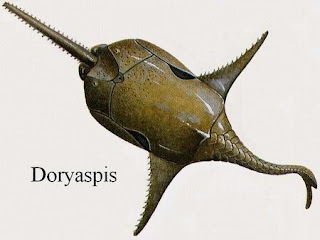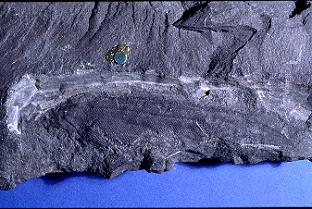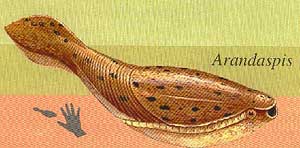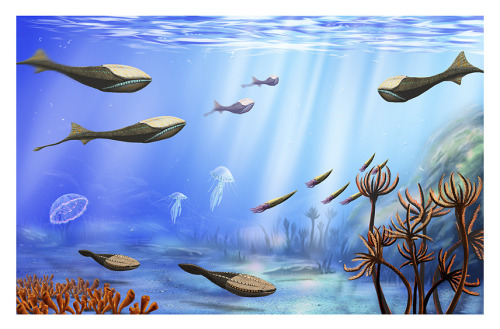[Recent Entries][Archive][Friends][User Info]
Below are the 20 most recent journal entries recorded in the "Сообщество, посвящённое ра" journal:| September 19th, 2011 | |
|---|---|
| 08:38 pm [industrialterro] [Link] |
Псаммолепис Псаммолепис (Psammolepis) — род гигантских бесчелюстных рыб отряда гетерострак (Heterostraci (англ.)) семейства псаммостеид (Psammosteidae (англ.)). Возможно, крупнейшее бесчелюстное достигавшее длины 2 м и ширины более метра. Имело уплощённое дорсо-вентрально тело и дорсально расположенный рот. Очень похож на дрепанасписа (Drepanaspis (англ.)). Вёл придонный образ жизни. Обитал в среднем девоне Европы и Гренландии, а также в позднем девоне Канады и Центральной Азии. Псаммолепис (Psammolepis) - род вымерших бесчелюстных рыб. Жили в начале девона до позднего девона Северной Америки, России и Европе. Тело длиной до 80 см (возможно были длиной до 2 метров и шириной более метра), широкое и плоское, покрыто массивным панцирем из трёхслойных костных пластинок. 10 видов. Питались донными животными. В дельтовых песчаных отложениях среднего и верхнего девона Восточно-Европейской платформы и Шотландии найдены пластины панциря и чешуя.
Древнейшие, описанные до сих пор позвоночные, происходят из нижнего ордовика Европы. Это роды Palaeodus и Acrodus, относимые к бесчелюстным рыбообразным подкласса Heterostraci. На рисунке в толще воды изображены значительно более поздние - нижнедевонские представители Heterostraci, относимые к роду Pteraspis. Эти панцирные бесчелюстные рыбообразные с удлиненным рылом пытаются уйти от преследования Osteolepis (справа вверху), пресноводной кистеперой (т.е. с окостеневшим внутренним скелетом) рыбы, имевшей кроме жабр зачаточные легкие, в виде воздушных пузырей. Osteolepis, достигавший в длину 25 см, жил в девоне, примерно 350 млн. лет тому назад;он является родоначальником длиннейшего эволюционного ряда, в конце которого стоит человек. Слева представлены два других вида бесчелюстных панцирных рыбообразных, относимых к Heterostraci: на переднем плане придонный детритоядный Drepanaspis с плоским туловищем, покрытым толстым костным щитом (длина 35 см), над ним Psammolepis (прим. - на среднем плане слева, зелёного цвета).
Tags: Вымершие бесчелюстные, Девон |
| 08:16 pm [industrialterro] [Link] |
Doryaspis Doryaspis ("Dart Shield") (also known by its synonym, "Lyktaspis") is an extinct genus of primitive jawless fish that lived in the Devonian period. Fossils have been discovered in Spitsbergen. The animals had a canteen-shaped body armor, and had large branchial plates that extended out and curved downward in a triangular shape, very similar to those of the pycnosteids. An element of the median oral plates (that would correspond to the lower lip or chin in gnathostomes) extends out in a long rod-shaped appendage, called the "pseudorostrum." The tail is long and slender, and has large rows of thick scales. In the type species, D. nathorsti, the lateral edges of the branchial plates and of the pseudorostrum are serrated. The second species, D. arctica, is smaller, and lacks serrated edges.
Tags: Вымершие бесчелюстные, Девон |
| 08:03 pm [industrialterro] [Link] |
Thelodus Thelodus is an extinct genus of primitive jawless fish that lived in the Silurian period. Fossils have been found worldwide. Thelodus belonged to the Thelodonti, a group of jawless fish lacking the armored plating characteristic of the related Heterostraci. The position of Thelodus`s mouth suggests that it fed on the ocean floor. Despite this lifestyle it was also a good swimmer, as indicated by its elongated lower caudal lobe and stabilizing dorsal fin, anal fin and paired pectoral fins.
Tags: Вымершие бесчелюстные, Силур |
| 07:56 pm [industrialterro] [Link] |
Boreaspis Boreaspis ("Boreas' Shield") is an extinct genus of primitive jawless fish that lived in the Devonian period. Fourteen different species of Boreaspis have been found in sandstone of the lagoons and estuaries of Devonian Spitsbergen. Boreaspis was about 13 centimetres (5.1 in) long, with a tough shield covering its head, and extra protective spikes protruding from the cheek regions. It also had a long spike-like rostrum on its snout, which would have enhanced the fish's hydrodynamics and was probably also used to root out food buried beneath the substrate.
Tags: Вымершие бесчелюстные, Девон |
| September 18th, 2011 | |
| 05:25 pm [industrialterro] [Link] |
Pteraspis Pteraspis (meaning wing shield) is an extinct genus of primitive jawless fish that lived in the Devonian period of what is now Britain and Belgium. Like other heterostracan fishes, Pteraspis had a protective armored plating covering the front of its body. Though lacking fins other than its lobed tail, it is thought to have been a good swimmer thanks to stiff, wing-like protrusions derived from the armoured plates over its gills. This, along with the horn-like rostrum, made Pteraspis very streamlined in shape; a perfect quality for a good swimmer. Pteraspis also had some stiff spikes on its back, possibly an additional form of protection against predators. It is thought to have fed from shoals of plankton just under the ocean surface, and is found in association with marine fossils. Pteraspis grew to a length of 8 inches (20 centimeters).
Tags: Вымершие бесчелюстные, Девон |
| 05:17 pm [industrialterro] [Link] |
Pituriaspis doylei Pituriaspis doylei ("Doyle's Pituri Shield") was one of two known species of jawless fish belonging to the Class Pituriaspida, and is the better known of the two. The species lived in estuaries during the Middle Devonian, in what is now the Georgina Basin of Western Queensland, Australia. The first specimens of P. doylei were actually empty sandstone casts of the head shields, with none of the original bone remaining. P. doylei vaguely resembled the Osteostraci, though neither are considered to be close relatives. The headshield extends posteriorly to form a long abdominal division which probably reached the anal region. The dorsal portion of its head armor differs from osteostracans in that the orbits of the eyes are set apart from each other, and that the shield has no pineal foramen (the "hole" between the eyes of Cephalaspis and its relatives), and that an opening at the base of the rostrum gives very little hints about the nature of the nasal openings. The exoskeleton is ornamented with tiny rounded tubercles. A unique characteristic of the Pituriaspida is a peculiar pit, which may have held some sort of sensory organ in life, located ventrally to the orbits, known as the adorbital depression. Almost nothing is known of the rest of the body, save that it had a pair of well-developed pectoral fins, similar to gnathostome fish.
Tags: Вымершие бесчелюстные, Девон |
| 05:13 pm [industrialterro] [Link] |
Palaeospondylus Palaeospondylus gunni ("Gunn's Ancient Vertebrae") is a mysterious, fish-like fossil vertebrate. Its fossils are described from Achannaras slate quarry in Caithness, Scotland. The fossil as preserved is carbonized, and indicates an eel-shaped animal of up to 6 centimetres (2 in) in length. The skull, which must have consisted of hardened cartilage, exhibits pairs of nasal and auditory capsules, with a gill-apparatus below its hinder part, but no indications of ordinary jaws. The phylogeny of this bizarre fossil has puzzled scientists since its discovery in 1890, and many taxonomies have been suggested. In 2004, researchers proposed that Palaeospondylus was a larval lungfish. Previously it had been classified as a larval tetrapod, unarmored placoderm, an agnathan, and a chimaera.
Tags: Вымершие бесчелюстные, Девон |
| 04:55 pm [industrialterro] [Link] |
Lepidaspis Lepidaspis serrata ("Serrated Scaley Shield") is an extinct heterostracan jawless fish from Early Devonian Canada. Its genus name refers to the fact that the shield is composed of hundreds of tiny scales. Although it is regarded as a heterostracan, its exact placement is regarded as incertae sedis, as the fact that it is currently impossible to discern where its dorsal and ventral plates (which are made up of a mosaic of the aforementioned tiny scales) end or begin. Some experts regard it as being descended from the basal heterostracans of the Silurian.
Tags: Вымершие бесчелюстные, Девон |
| 04:39 pm [industrialterro] [Link] |
Hemicyclaspis Hemicyclaspis (meaning half-round shield or semicircle plate) is an extinct genus of primitive jawless fish, closely related to Cephalaspis, that lived in the Devonian period in what is now Europe and North America. A typical cephalaspid, Hemicyclaspis had a heavily armored, shovel-shaped headshield. It is thought to have been a better swimmer than most of its relatives because of its powerful tail, stabilizing dorsal fin and the keel-shaped hydrodynamic edges of its head shield. Hemicyclaspis probably foraged the ocean floor for food. Hemicyclaspis grew to a length of 5 inches (13 centimeters) and would most likely have fed on particles from the muddy sea bed.
Tags: Вымершие бесчелюстные, Девон |
| 04:19 pm [industrialterro] [Link] |
Drepanaspis Drepanaspis gemuendenensis is an extinct species of primitive jawless fish from the Devonian Hunsrück lagerstätte. It was a flattened creature with a heavily armored body, somewhat ray-like in appearance. Its mouth faced upwards, unlike most other Heterostracans, which had their mouths facing downward. Drepanaspis also had small, widely spaced eyes. It is presumed to have foraged the ocean floor for food. This frying-pan shaped fish may have been the ancestor of the giant, meter-long, meter-wide Psammosteid heterostracans of the late Devonian.
Среднедевонская фауна (на переднем плане только один агнат Дрепанаспис ((Drepanaspis) в левом нижнем углу), жил в нижнем девоне).
Tags: Вымершие бесчелюстные, Девон |
| 03:50 pm [industrialterro] [Link] |
Cephalaspis Cephalaspis ("Head Shield") was a genus of armored goldfish-sized to trout-sized detritivorous fish that lived in freshwater streams and estuaries of early Devonian Western Europe. It is a member of the Osteostraci, one of many groups of Palaeozoic armoured jawless fish. Like its immediate osteostracan ancestors, Cephalaspis was heavily armored, presumedly to defend against predatory placoderms and eurypterids, as well as to serve as a source of calcium for metabolic functions in calcium-poor freshwater environments. It had sensory patches along the rim and center of its head shield, which were used to sense for worms and other burrowing organisms in the mud. Because its mouth was situated directly beneath its head, Cephalaspis was thought of as being a bottom-feeder, akin to a heavily armoured catfish or sturgeon. It moved its plow-like head from side to side, Cephalaspis easily stirring sand and dust into the water, along with revealing the hiding places of its prey, digging up worms or crustaceans hidden in the mud and algae, as well as sifting through detritus. Cephalaspis belongs to the Osteostraci, a group which is widely believed to be the sister group to all jawed vertebrates. So whilst Cephalaspis was not a direct ancestor of the jawed vertebrates, Cephalaspis and jawed vertebrates nevertheless shared a common ancestor.
Tags: Вымершие бесчелюстные, Девон |
| September 13th, 2011 | |
| 08:42 pm [industrialterro] [Link] |
Tremataspis Tremataspis is an extinct genus of primitive jawless fish from the Silurian period of what is now Estonia. An osteostracid, Tremataspis was about 10 centimetres (3.9 in) in length, and had an armored shield covering its head. Compared with its relatives, the shield was unusually elongated, covering the whole front of the body, and was more rounded in shape. It is thought that Tremataspis used its rounder shield to burrow in the ocean floor, searching for food. Because the shield consisted of one solid piece, it probably did not grow during the animal's life; presumably, the larvae lacked the shield, which only appeared later in life.
Tags: Вымершие бесчелюстные, Силур |
| 08:32 pm [industrialterro] [Link] |
Pharyngolepis Pharyngolepis is an extinct genus of primitive jawless fish that lived in the Silurian period of what is now Norway. Pharyngolepis had well-developed anal an caudal fins, but no paired or dorsal fins that would have helped stabilise it in the water, and so was probably a poor swimmer, remaining close to the sea bottom. The pectoral fins were instead replaced by bony spines, possibly for protection against predators, and there was a row of spines along the back. It probably scooped up food from the ocean floor.
Tags: Вымершие бесчелюстные, Силур |
| 08:12 pm [industrialterro] [Link] |
Jamoytius kerwoodi Jamoytius kerwoodi was a species of primitive, eel-like jawless fish that lived in the Silurian period. J. kerwoodi is the earliest known anaspid. It had long, paired fins running along its body - making it a good swimmer. J. kerwoodi resembled a lamprey, especially with its rounded mouth and elongated body. However, as it had no teeth or teeth-like structures in its mouth, it was not carnivorous like its distant modern-day relative, the lamprey. It was more likely to have been a filter-feeder or a detrius-feeder, possibly in the manner of larval lampreys. The fish had a cartilaginous skeleton, and a branchial basket resembling the cyclostomes - used to suggest that it was a near-ancestor to that clade. It is also the earliest known vertebrate with camera-type eyes. It also possessed weakly mineralised scales.
Tags: Вымершие бесчелюстные, Силур |
| 08:01 pm [industrialterro] [Link] |
Furcacauda Furcacauda is a genus within the family of Furcacaudidae, within the order Thelodonti, the Class Agnatha, and the Subphylum Vertebrata. Canadian fossils give rise to the Furcacaudiformes during the Devonian and Silurian time periods. Furcacaudiformes were deep water jawless vertebrates with symmetrical fork and lobed-finned tails and smaller than typical loganellid and nikoliviid thelodonti scales. Furcacaudiformes are noted to having a laterally compressed body, large anterior eyes, slightly posterior, lateral, and vertical to a small mouth, and a condensed curved row of branchial openings (gills) directly posterior to the eyes. Many but not all had laterally paired fins. Wilson and Caldwell also note the presence of a caudal peduncle and a long caudal fin made of two large lobes, one dorsal and one ventral separated by 8 to 14 smaller intermediate lobes, giving the appearance of a striated half-moon shaped tail resembling the tail of a heterostracan. A large square cavity within the gut connecting a small intestine to a anal opening lead many to believe that it is this genus that exhibits the first vertebrate stomach. According to Wilson and Caldwell their discovery, based on sediment infillings of fossils of the Furcacauda heintze, gives credence to the evolutionary development of stomach before jaws.
Tags: Вымершие бесчелюстные, Силур |
| 07:38 pm [industrialterro] [Link] |
Birkenia Birkenia is a genus of extinct anaspid fish from the Late Silurian to the Early Devonian of Europe. It reached a length of 4 in (10 cm) and was an active swimmer. Birkenia has a characteristic row of anterior and posterior pointing dorsal scutes. Approximately on the middle of the back there is a larger scute pointing anterior as well as posterior. In front of the head there is a round patch containing tiny scales. A row of slanting round gill apertures lead to the gill chambers, so the fish could take oxygen independently of the mouth. The tail is hypocercal, which means that the lower lobe is the longest. This has confused Traquair when he initially described this fish because he never met this conditon and therefore reconstructed Birkenia upside down. Well preserved specimens show an anal fin anterior to the tail. Birkenia was adapted for active swimming, and its sucking mouth was in a terminal rather than a ventral position. The head of Birkenia was covered by small scales rather than by the fused bony shield of some of its relatives.
Tags: Вымершие бесчелюстные, Силур |
| September 4th, 2011 | |
| 04:37 pm [industrialterro] [Link] |
Sacabambaspis Sacabambaspis is an extinct genus of jawless fish that lived in the Ordovician period. It is related to Astraspis. Sacabambaspis had a head shield made from a large upper (dorsal) plate that rose to a slight ridge in the midline, and a deep curved lower (ventral) plate. Also it had narrow branchial plates which link these two along the sides, and cover the gill area. The rest of body was covered by long, strap-like scales behind the head shield. The eyes were far forward and between them are possibly two small nostrils, and the mouth was armed with very thin plates (oral plates). The fossils of Sacabambaspis and Astraspis show clear evidence of a sensory structure (lateral line system). The arrangement of these organs in regular lines allows the fish to detect the direction and distance from which a disturbance in the water is coming.
Ископаемые останки Sacabambaspis :
Tags: Вымершие бесчелюстные, Ордовик |
| 04:01 pm [industrialterro] [Link] |
Astraspis Astraspis ('star shield') is an extinct genus of primitive jawless fish from the Ordovician of Central North America and Bolivia (Gagnier, 1993) . It is related to other Ordovician fishes, such as the South American Sacabambaspis, and the Australian Arandaspis. Astraspids are hypothesized to have been about 200mm in length. They are supposed to have had a mobile tail covered with small protective plates (<1mm) and a head region covered with much larger plates (>>2mm). The specimen from North America (described by Sansom et al., 1997) is to have had relatively large, lateral eyes and a series of eight gill openings on each side. The specimen was generally oval in cross-section. The protective bony plates covering the animal were composed of aspidin (chemically similar to modern shark's teeth), covered by tubercles composed of dentine. It is from these tubercles (which are generally star-shaped) that the name 'Astraspis' (literally "star-shield") is derived.
Tags: Вымершие бесчелюстные, Ордовик |
| 02:26 pm [industrialterro] [Link] |
Arandaspis В ордовике продолжается развитие бесчелюстных рыбообразных, которые достигнут своего максимального разнообразия в верхнем силуре - нижнем девоне. Arandaspis prionotolepis is an extinct species of jawless fish that lived in the Ordovician period, about 480 to 470 million years ago. It is the oldest known vertebrate (прим. - древнейшие позвоночные существовали ещё в кембрийском периоде - см. Хайкоихтис). Its remains were found in Alice Springs, Australia in 1959, but it was not discovered that they were the oldest known vertebrates until the late 1960s. Arandaspis is named after a local Aboriginal tribe, the Aranda (currently called Arrernte). Arandaspis was about 15 cm (6 in) long, with a streamlined body covered in rows of knobbly armoured scutes. The front of the body and the head were protected by hard plates with openings for the eyes, nostrils and gills. Although it had no jaws, Arandaspis might have had some moveable plates in its mouth, serving as lips, sucking in food particles. The low position of its mouth suggests Arandaspis foraged the ocean floor. It had no fins; its only method of propulsion was its horizontally flattened tail. As a result, it probably swam in a fashion similar to a modern tadpole. Репродукции: (1, 2, 3, 4, 5)
Tags: Вымершие бесчелюстные, Ордовик |
| August 3rd, 2011 | |
| 10:59 am [industrialterro] [Link] |
Хайкоихтис Haikouichthys ercaicunensis — вид ископаемых хордовых из группы бесчелюстных (Agnatha). Родовое название означает «рыба из Хайкоу». Мелкое (2,5 см) водное хордовое кембрийского периода. Жил, примерно, 535 млн лет назад. Примитивный хрящевой позвоночник позволял ему плавать совсем иначе, чем это делали членистоногие животные. Маленькое тельце хайкуихтиса было лишено плавников, но зато у животного были глаза, жабры, нос, уши и головной мозг, что делало его самым продвинутым обитателем древних кембрийских морей. Вполне возможно, что хайкуихтис был гермафродитом (то есть каждое животное имело и мужские, и женские половые органы) и откладывал яйца, из которых вылуплялись крошечные личинки. Кожа хайкуихтиса, как и его далёких потомков, современных миног и миксин, была покрыта слизью. По-видимому, хайкуихтисы жили крупными стаями из нескольких сотен особей, что помогало им спасаться от хищников. Судя по небольшим размерам и своеобразной форме тела, плавали хайкуихтисы плохо. В основном они держались у морского дна, где собирали мелкие частицы пищи. На некоторых хорошо сохранившихся окаменелостях хайкуихтиса сохранились даже отпечатки внутренних органов и желез, вырабатывавших кожную слизь.
Tags: Вымершие бесчелюстные, Кембрий |



























































































